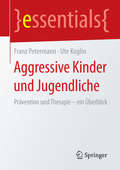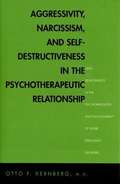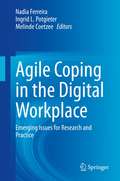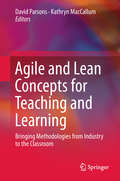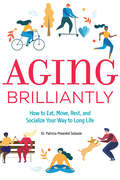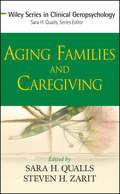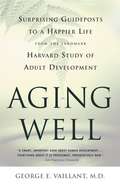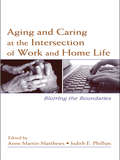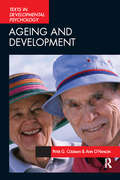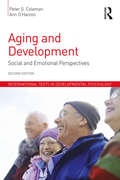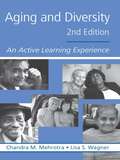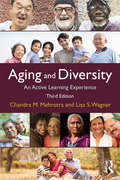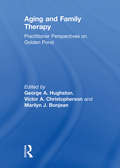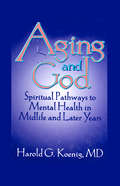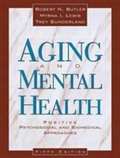- Table View
- List View
Aggressive Kinder und Jugendliche: Prävention und Therapie – ein Überblick (essentials)
by Franz Petermann Ute KoglinDas Essential bietet eine aktuelle Übersicht zu Ansatzpunkten für die Prävention aggressiven Verhaltens bei Kindern und Jugendlichen sowie Informationen über wirksame Präventionsangebote und therapeutische Grundprinzipien bei der Behandlung. Die Autoren schildern, wie durch Einbeziehung des sozialen Umfeldes langfristig Erfolge bei der Prävention und Behandlung eines solchen Problemverhaltens erzielt werden können. Neu entwickelte, altersspezifische Therapieansätze (z. B. soziale Kompetenztrainings, Elterntrainings, multisystematische Therapie), die sich als besonders wirksam erwiesen haben, werden vorgestellt. Auf diese Weise können auch aggressive Kinder und Jugendliche zu sozial kompetenten, selbstbewussten Erwachsenen heranwachsen.
Aggressivity, Narcissism, and Self-destructiveness in the Psychotherapeutic Relationship: New Developments in the Psychopathology and Psychotherapy of Severe Personality Disorders
by Otto F. KernbergThis book starts out with a proposal for a general classification of personality disorders that includes such categorical and dimensional criteria. It then proceeds to analyze the vicissitudes of negative affect development, from the normal affect of rage to its complex characterological consequences in the psychopathology of hatred and envy and the characterological transformations of these emotions into chronic self-destructive behavior.
Agile Coping in the Digital Workplace: Emerging Issues for Research and Practice
by Melinde Coetzee Ingrid L. Potgieter Nadia FerreiraThis volume outlines emerging issues for research and practice related to agile coping dynamics in the digital era. Chapters in this book report on current research on the key constructs and processes underlying coping dynamics in multi-disciplinary domains and across the life-span. Chapters compare current research trends in terms of future potential directions for research on coping dynamics in the digital era. The book also critically evaluates the relevance, applicability and utility of the research findings and theoretical premises in various classical, current and potential emerging issues for research and practice in the smart digital technological world of work for employee across their careers.Among the topics discussed:The digital era: contextual issues and copingIssues for organizational practiceIssues for individualsCoping within the employability contextAgile Coping in the Digital Era provides theoretical premises and research perspectives, while also evaluating the practical utility of theory and research ideas for management and employee practices in Industry 4.0 organizational contexts.
Agile Resilience: The psychology of developing resilience in the workplace (Business in Mind)
by Tom DillonFinalist in the Wellness and Wellbeing Category of the Business Book Awards 2023. Everything you need for strengthening and flexing your resilience muscle!Resilience can mean something different to everyone, yet it is increasingly necessary to survive in the modern workspace, whether that is at home, in an office or other place of work. Hard times for organisations generally mean harder times for employees, often with increased workloads and reduced resources. Being able to navigate this environment and remain resilient is preferable, but when stress and anxiety take over you need to know how to boost your resilience and look after your own well-being. An essential read for anyone working today, this book focuses on the concept of agile resilience, exploring how resilience can be learned, chosen, developed and adapted to help you cope with the range of circumstances and experiences you may face. It explains what resilience is, including your own personal take on that, what might deplete it, the impact of Covid-19, and how you can maintain or replenish it when necessary in order to thrive in your work and life.
Agile Werte- und Kompetenzentwicklung: Wege in eine neue Arbeitswelt
by Werner Sauter Roman Sauter Roland WolfigDas Werk zeigt, wie selbstorganisierte und personalisierte Werte- und Kompetenzentwicklung mit agilen Lernmethoden innerhalb eines strategieorientierten Ermöglichungsrahmens gestaltet werden kann, so dass Organisationen ihre Performanz für den kommenden Kompetenzwettbewerb entwickeln. Keine technische Revolution hat die Arbeits- und Lernwelt so radikal verändert, wie Digitalisierung und Vernetzung. Der Wettbewerb der Zukunft wird ein Kompetenzwettbewerb mit agilen Arbeitsmethoden sein. Kompetenzentwicklung ist die Bildung der Zukunft, da die Mitarbeiter sich heute auf Herausforderungen vorbereiten müssen, die gegenwärtig noch gar nicht existieren, auf die Nutzung von Technologien, die noch gar nicht entwickelt sind, um Probleme zu lösen, von denen wir heute noch nicht wissen, dass sie entstehen werden. Da dies mit dem tradierten Vorratslernen nicht zu leisten ist, ist ein Paradigmenwechsel in der betrieblichen Bildung erforderlich. Dabei ist Agilität mehr als nur eine Ansammlung von Methoden. Im Kern geht es vielmehr um eine Haltung bzw. ein Mindset, welches durch agile Praktiken unterstützt und gefördert wird. Diese Einstellung basiert auf einem Gerüst an verinnerlichten, agilen Werten, welche den Kompetenzaufbau sowohl einfordern als auch unterstützen.Die Unternehmen benötigen somit ein Werte- und Kompetenzmanagement, welches den Mitarbeitern gezielt ermöglicht, die erforderlichen Fähigkeiten selbstorganisiert und kreativ im Arbeitsprozess und im Netz aufzubauen. Dabei wachsen Arbeiten und Lernen zusammen. Dies setzt veränderte Arbeitsmethoden und Lernarrangements für personalisierte Werte- und Kompetenzentwicklungs-Prozesse, eine Lern-Infrastruktur für kollaboratives Arbeiten und Lernen sowie ein Veränderungsmanagement mit dem Ziel der Selbstorganisation voraus.
Agile Working and Well-Being in the Digital Age
by Emma Russell Christine GrantWithin the digital era, agile working is imperative for organisations and workers to meet the needs of customers, service-users and ever-changing markets. This needs to be achieved whilst meeting goals of effectiveness and well-being. In this book, state-of-the-art theory is used to understand how to optimise agile working by addressing key issues around personality, team-working and management. The authors define the concept of agile working and unpack often-misunderstood terms associated with this, such as remote working and telework. The book explores the well-being consequences of agile work including sedentary behaviours, digital distraction, and digital resistance before offering insights for the future. Examining current practice in the context of established and emerging theory, the book paves the way towards further advances in the field and supports organisations seeking to make agile working work for them. Agile Working and Well-being in the Digital Age provides a valuable new resource for practitioners and scholars in the fields of occupational and organizational psychology, human resource management, organisational development, mental health and well-being.
Agile and Lean Concepts for Teaching and Learning: Bringing Methodologies from Industry to the Classroom
by David Parsons Kathryn MacCallumThis book explores the application of agile and lean techniques, originally from the field of software development and manufacturing, to various aspects of education. It covers a broad range of topics, including applying agile teaching and learning techniques in the classroom, incorporating lean thinking in educational workflows, and using team-based approaches to student-centred activities based on agile principles and processes.Demonstrating how agile and lean ideas can concretely be applied to education, the book offers practical guidance on how to apply these ideas in the classroom or lecture hall, as well as new concepts that could spark further research and development.
Aging Brilliantly: How to Eat, Move, Rest, and Socialize Your Way to Long Life
by Dr. Patricia Pimentel SelassieLive well. Age slow. Aging doesn't have to mean getting old. There's mounting evidence that particular behaviors and lifestyles seem to lead to "more life." Aging Brilliantly is a guide to proven habits you can adopt at any age to help achieve not only longevity but also a happier, healthier existence. Inspired by studies of the longest living people in the world, Aging Brilliantly offers specific approaches to exercise, food, relationships, and relaxation that can greatly enhance vitality. Each chapter includes action plans and quick tips for you to apply these new principles swiftly so you can begin living better—today. Learn the secrets of healthy living: Super-aging action plan—After you learn the pillars, set up a step-by-step plan to help you define your personal goals and implement them. Self-assessment—Score yourself at the end of each chapter to evaluate where you fall in the spectrum of healthy aging. Become a master ager—With a small amount of daily practice, you'll master aging and become proficient in living a life that leads to vitality and longevity. Use the research-backed, self-care solutions in Aging Brilliantly to make age just a number.
Aging Families and Caregiving
by Steven H. Zarit Sara Honn QuallsWith the field of geriatric mental health growing rapidly in the next decade as the Baby Boomers age, this timely guide brings together a notable team of international contributors to provide guidance for caregivers, families, and those who counsel them on managing caregiving challenges for aging family members. Aging Families and Caregiving helps mental health professionals guide families and other caregivers as they adjust to the demands of caring for aging family members and provides essential guidelines for the professionals treating this special-needs population.
Aging Public Policy: Bonding the Generations (Society and Aging Series)
by Theodore H. Hoff Richard W. Park"Aging Public Policy: Bonding the Generations" is presented in three parts. Part One describes the policy process as a response to human needs through the laws of our country. Part Two explores the national policy development on behalf of older persons. Part Three describes the major public policies on behalf of the elderly that include Social Security, Medicare, The Older Americans Act, institutional care, employment and retirement policies. The final chapter discusses the advocacy process in the field of aging.
Aging Research - Methodological Issues
by Carmen García-Peña, Luis Miguel Gutiérrez-Robledo and Mario Ulises Pérez-ZepedaThis book reviews classical epidemiological and clinical research studies, with a focus on aging. Chapters cover methodological topics like the scientific method, ethics, and the consequences of certain exclusion criteria and the work includes a look at clinical concepts like multi morbidity, frailty and functionality. The authors reveal the issues and challenges for researchers of age and aging, and also consider the translation of scientific knowledge, from basic to clinical and from clinical to public policies of social and health care.The focus on aging is what gives this book its valuable perspective on research methodology. All authors have considerable experience in aging, geriatrics or gerontology and each chapter includes both a theoretical framework and practical examples of studies in aging. Readers will discover study designs that are reviewed for basic structure, main flaws and advantages and are analyzed for specific conditions and variables regarding aging.This text is suited to both health care professionals caring for older adults and researchers who are new to research in aging. It is relevant across the disciplines, including medicine, psychology, social sciences and dentistry and it supports learning with graphs and figures.
Aging Well: Surprising Guideposts to a Happier Life from the Landmark Study of Adult Development
by George E. VaillantThis is the acclaimed bestseller that reveals the scientific secrets to ensuring that our golden years are truly golden. Based on the longest and most complete study of adult development in the world, Aging Well draws from the individual histories of 824 men and women from a variety of backgrounds to illustrate the most important factors involved in reaching and enjoying a happy, healthy old age.
Aging and Caring at the Intersection of Work and Home Life: Blurring the Boundaries
by Anne Martin-MatthewsThere are not many books that address the boundaries of care of older people from a work-life perspective. This book, authored by contributors from various countries, looks at the boundaries of care by looking at private and public help, professional and personal help and paid and unpaid caregivers. It captures and conceptualizes the complexity of the intersection of work and home life as it relates to the provision of assistance and support to older relatives in a variety of "care work" contexts. It explores these issues within a critical framework, rather than from an assumed stress or burden perspective, which dominates current texts on the topic. Readers of this volume will gain a deeper understanding of issues of care provision amongst "networks" of careers and helpers, and of the particular dynamics of care when it is episodic or framed by constrains of space and time as a result of geography. In addition, each chapter addresses issues of diversity with sensitivity to gender, race and ethnicity. This book will be of use to academics and graduate students in Gerontology, Family Studies, IO psychology, Gender Studies and Sociology.
Aging and Development: Social and Emotional Perspectives (International Texts in Developmental Psychology)
by Peter Coleman Ann O'HanlonWith increasing numbers of the population living into old age, we need a better understanding of the nature and experience of ageing in all its aspects. Up to now, very few texts have considered this in any depth, but 'Ageing and Development', a new volume in the Texts in Developmental Psychology series, provides a detailed and comprehensive overview of the theories and research in adult development into old age. The classic early accounts of theorists such as Jung and Erikson are considered, as well as their present day successors. Particular attention is given to theories of adjustment to loss, and to the threat of loss, which dominate current gerontological research.A notable feature of the book is the separate section devoted to the psychology of advanced old age, to life in states of physical and/or mental frailty, and to the survival of the self in these circumstances. There is a strong emphasis throughout on up-to-date empirical research and illustrative case examples. The reader is constantly encouraged to take a critical perspective, to understand the strengths and limitations of different studies, and to think about the issues raised in terms of their own lives.
Aging and Development: Social and Emotional Perspectives (International Texts in Developmental Psychology)
by Peter G. Coleman Ann O'HanlonThe psychology of aging usually focuses upon cognitive changes, with a particular focus on dementia and other forms of cognitive decline. But getting older is about more than simply changes to the brain and related health issues. Changes to our social and emotional lives are also hugely significant as we adapt across our lifespan. The second edition of Aging and Development is the only textbook available that responds to the growing interest in social, personal and emotional development in older age. Ideally suited to complement texts on cognitive change, the book provides a holistic developmental perspective on aging. It highlights a range of issues, including the development of personal meaning and spirituality, improvements in emotional control, uses of reminiscence and life review, the importance of healthy attitudes to aging, as well as the maintenance of close personal relationships. It does not avoid the difficult issues of late life decline, but illustrates how even in circumstances of physical and mental frailty a positive sense of self can be created and enhanced. Fully updated to provide the most cutting-edge overview on this burgeoning topic of interest, Aging and Development includes a glossary and list of useful websites both on the study of gerontology and the psychology of aging. It will be essential reading for all students of developmental psychology, as well as anyone either training to work or already working with older people.
Aging and Developmental Disability: Current Research, Programming, and Practice Implications
by Joy Hammel Susan NochajskiAging and Developmental Disability: Current Research, Programming, and Practice Implications explores research findings and their implications for practice in relation to normative and disability-related aging experiences and issues. This valuable book discusses the effectiveness of specific interventions targeted toward aging adults with developmental disabilities such as Down's Syndrome, cerebral palsy, autism, and epilepsy, and offers suggestions for practice and future research in this area.
Aging and Disabilities: Seeking Common Ground
by James J CallahanThis book helps in ...building a bridge between the networks...The topics of aging and disabilities are multifaceted and therefore may be approached in many ways. The editors have chosen to focus on four systems and areas of common ground (aging, developmental disabilities, independent living movement, and rehabilitation), to investigate the emerging "intersection" of the two fields.
Aging and Diversity
by Stephen Fried Lisa S. Wagner Chandra M. MehrotraThis new edition has been completely rewritten and includes chapters that address key topics in diversity and aging: research methods, psychological aging; health beliefs, behaviors, and services; health disparities; informal and formal care for older persons; work and retirement; religious affiliation and spirituality; and death, dying, and bereavement. Taking a broad view of diversity, Mehrotra and Wagner discuss elements of diversity such as gender, race or ethnicity, religious affiliation, social class, rural-urban community location and sexual orientation. Including these elements allows them to convey some of the rich complexities of our diverse culture - complexities that provide both challenges to meet the needs of diverse population and opportunities to learn how to live in a pluralistic society. Throughout the book, Mehrotra and Wagner present up-to-date knowledge and scholarship in a way that engages readers in active learning. Rather than simply transmitting information, the authors place ongoing emphasis on developing readers' knowledge and skills; fostering higher order thinking and encouraging exploration of personal values and attitudes. Distinctive features of the book include: Opening vignettes for each chapter that present a sampling of how the issues to be discussed apply to diverse elders. Active learning experiences that invite readers to interview diverse elders, conduct internet searches, and give an analysis of a case study. Quizzes at the end of the chapters help readers ascertain the extent to which they have learned the material; the key for each quiz includes details about correct and incorrect responses so that additional learning can occur. Aging and Diversity Online boxes interspersed throughout the book provide internet resources that readers may use to find new research and publications. Suggested readings and audiovisual resources given at the end of each chapter serve as a guide to additional information on topics covered in the chapter. This approach of presenting the material will help the readers understand and apply key concepts and principles in ways that will not only improve the lives of older people they serve, but will also enhance their own aging experience.
Aging and Diversity: An Active Learning Experience
by Chandra Mehrotra, Ph.D. Lisa Smith WagnerAs the older population in the United States is becoming more racially and ethnically diverse, it is important to understand the characteristics, the potential, and the needs of this population. In this new and fully revised edition of Aging and Diversity, Chandra Mehrotra and Lisa Wagner address key topics in diversity and aging, discussing how the aging experience is affected by not only race and ethnicity but also gender, religious affiliation, social class, rural-urban community location, and sexual orientation and gender identity. Taking this broad view of human diversity allows the authors to convey some of the rich complexities facing our aging population – complexities that provide both challenges to meet the needs of a diverse population of elders and opportunities to learn how to live in a pluralistic society. Mehrotra and Wagner present up-to-date knowledge and scholarship about aging and diversity in a way that engages readers in active learning, placing ongoing emphasis on developing readers’ knowledge and skills, fostering higher order thinking, and encouraging exploration of personal values and attitudes.
Aging and Diversity: Social and Community Contexts of Aging
by Lisa Wagner Man Guo Chandra M MehrotraAging and diversity intersect in important ways, as individuals from different backgrounds experience aging through distinct lenses shaped by traditions, values, and beliefs. As the older population in the United States is becoming more diverse, it is important to understand the characteristics, the potential, and the needs of this population.In this new and fully revised edition of Aging and Diversity, Lisa S.Wagner, Chandra Mehrotra, and Man Guo address key topics in diversity and aging, discussing how the aging experience is affected by not only race and ethnicity but also gender, religious affiliation, socioeconomic status, rural–urban community location, and sexual orientation and gender identity. Taking this broad view of human diversity allows the authors to convey some of the rich complexities facing aging populations—complexities that provide both challenges to meet the needs of a diverse population of elders and opportunities to learn how to live in a pluralistic society.Wagner, Mehrotra, and Guo present up-to-date knowledge and scholarship about aging and diversity in a way that engages readers in active learning, placing ongoing emphasis on developing readers’ knowledge and skills, fostering higher-order-thinking, and encouraging exploration of personal values and attitudes.
Aging and Family Therapy: Practitioner Perspectives on Golden Pond
by George Hughston Victor Christopherson Marilyn BojeanEnhance the intervention strategies you use in therapy with older adults and their families. This significant new book provides practitioners with information, insight, reference sources, and other valuable tools that will contribute to more effective intervention with the elderly and their families. Outstanding scholars have contributed original material that addresses the major issues in treating the elderly from the practitioner’s point of view; the biological, psychological, social, and spiritual concerns of the aged are examined in order to formulate a systemic and comprehensive treatment plan. Destined to become a classic in a challenging new area of psychotherapy, the unique Aging and Family Therapy promises to guide and inform practitioners who will be called upon to provide assistance to the increasing number of older adults who will be in need of mental health services.
Aging and God: Spiritual Pathways to Mental Health in Midlife and Later Years
by William M Clements Harold G KoenigThis important book examines the relationship between religion and mental health throughout the life cycle, with a special emphasis on later life. It asserts that successful aging is possible regardless of physical health or environmental circumstances, and that religious beliefs and behaviors may facilitate successful aging. Aging and God thoroughly examines the effects of religion and mental health on aging and provides a centralized resource of up-to-date references of research in the field. It focuses on recent findings, theoretical issues, and implications for clinical practice and contains ideas for further research. In Aging and God, you’ll also find information on project design that can help you develop grant applications and carry out studies.Aging and God is a helpful book for both mental health and religious professionals. It helps mental health specialists better understand the spiritual needs of older adults and the impact that religion can have on facilitating mental health. It also describes how religion can be utilized in clinical practice and integrated into psychotherapeutic approaches to older patients. The book brings religious professionals current knowledge of the major psychological problems that older adults face and how religion can be used to help alleviate these problems.Full of pertinent information, Aging and God addresses theoretical aspects of human development, focusing on cognitive, moral, and religious faith development examines situations and disorders of particular concern to older persons and looks at how religion can be used as a resource applies research findings to the problem of meeting the spiritual and mental health needs of elders with chronic or acute health problems provides an in-depth look at end-of-life issues such as physician-assisted suicideHospital and nursing home chaplains will find this book informative and encouraging, as will gerontologists, hospital administrators, and community clergy faced with increasingly older congregations. It gives mental health professionals new strategies to help improve the later years of older adults, and makes an excellent text for courses on religion, mental health, and aging. Middle-aged and older adults, as well as their families, will also find Aging and God enjoyable and inspiring as they attempt to grapple with the myriad adjustment and coping problems associated with aging.
Aging and Mental Health (Understanding Aging)
by Daniel L. Segal Sara Honn Qualls Michael A. SmyerFully updated and revised, this new edition of a highly successful text provides students, clinicians, and academics with a thorough introduction to aging and mental health. The third edition of Aging and Mental Health is filled with new updates and features, including the impact of the DSM-5 on diagnosis and treatment of older adults. Like its predecessors, it uses case examples to introduce readers to the field of aging and mental health. It also provides both a synopsis of basic gerontology needed for clinical work with older adults and an analysis of several facets of aging well. Introductory chapters are followed by a series of chapters that describe the major theoretical models used to understand mental health and mental disorders among older adults. Following entries are devoted to the major forms of mental disorders in later life, with a focus on diagnosis, assessment, and treatment issues. Finally, the book focuses on the settings and contexts of professional mental health practice and on emerging policy issues that affect research and practice. This combination of theory and practice helps readers conceptualize mental health problems in later life and negotiate the complex decisions involved with the assessment and treatment of those problems. Features new material on important topics including positive mental health, hoarding disorder, chronic pain, housing, caregiving, and ethical and legal concerns Substantially revised and updated throughout, including reference to the DSM-5 Offers chapter-end recommendations of websites for further information Includes discussion questions and critical thinking questions at the end of each chapter Aging and Mental Health, Third Edition is an ideal text for advanced undergraduate and graduate students in psychology, for service providers in psychology, psychiatry, social work, and counseling, and for clinicians who are experienced mental health service providers but who have not had much experience working specifically with older adults and their families.
Aging and Mental Health: Positive Psychosocial and Biomedical Approaches
by Robert N. Butler Myrna I. Lewis Trey SunderlandDesigned for professionals working with the elderly, this text provides comprehensive coverage of the ageing process and its effects on mental health. It sets out the nature and problems of old age, including the problems of older people in their families, and explores some of the common emotional problems and psychiatric disorders which can affect the elderly. It also outlines the evaluation, treatment and prevention of some common effects of ageing. There is specific coverage of race, ethnicity, gender, crime, alcoholism and physical disabilities, including deafness and blindness.
Aging and Older Adulthood (Wiley Desktop Editions Ser.)
by Joan T. ErberThe third edition of this essential text has been updated and expanded with new material that reflects the most recent developments in the field, and explores our current understanding of a broad range of topics related to aging and older adulthood. Fresh edition includes updated content such as revised case histories and reworked material on key concepts and research applications Retains the winning format of the second edition, with chapter contents framed by individual histories Dual models add cohesiveness to the presentation of theory Thematic structure facilitates reader comprehension Instructor resources provided online upon publication at www.wiley.com/go/erber
